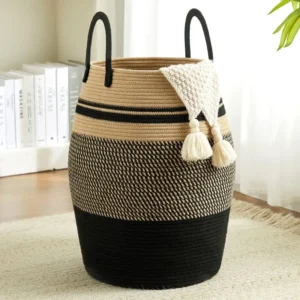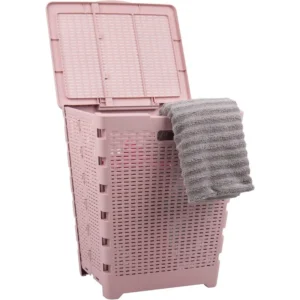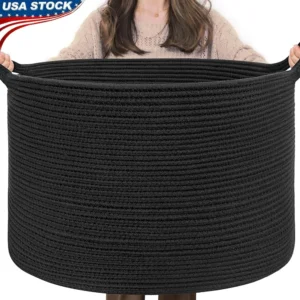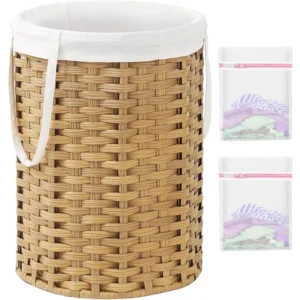Introduction: Why Your Laundry Basket Material Matters
The humble laundry basket plays a crucial role in our daily lives, yet many of us give little thought to what it’s made from. Your choice of laundry basket material affects everything from how long it lasts to how it complements your home decor. The right basket doesn’t just hold your clothes—it can prevent mold growth, protect delicate fabrics, and even make laundry day a bit more pleasant.
When choosing between natural and synthetic materials, several factors come into play:
- Durability and longevity (most households use their laundry baskets multiple times weekly)
- Moisture resistance and breathability (especially important for damp clothes)
- Aesthetic appeal and how it fits with your home style
- Environmental impact and sustainability concerns
Studies show that the average laundry basket lasts 3-7 years, with significant variation based on material quality and care. At Tidy Treasure, we specialize in premium storage solutions that balance beauty and functionality, giving you options that last longer while enhancing your space.
In this guide, we’ll compare natural materials like wicker, rattan, and bamboo with synthetic options such as plastic and polyester to help you make an informed choice based on your specific needs. Understanding the natural wicker vs synthetic differences can significantly impact both functionality and aesthetics in your home. Whether you’re looking for durability, style, or eco-friendliness, our comprehensive laundry solutions guide will help you find the perfect match.
Understanding Laundry Basket Material Characteristics
Before diving into specific materials, it’s helpful to understand the key characteristics that determine a laundry basket’s performance. These qualities affect not only how well the basket functions but also how long it lasts and how it fits into your home environment.
| Characteristic | Importance | What It Means For You |
|---|---|---|
| Durability | High | Determines how long your basket will last before needing replacement |
| Moisture Resistance | High | Affects mold/mildew development and basket longevity |
| Breathability | Medium-High | Prevents odors and allows damp clothes to dry rather than grow musty |
| Weight | Medium | Impacts portability, especially when fully loaded with laundry |
| Aesthetics | Varies | Determines how well the basket complements your home décor |
| Eco-friendliness | Varies | Reflects environmental impact of production and disposal |
| Maintenance | Medium | Affects how much care is needed to keep the basket clean and functional |
Your ideal laundry basket material depends largely on your priorities. Someone in a humid climate might prioritize breathability and mold resistance, while someone focused on aesthetics might choose a material that complements their home décor, even if it requires more maintenance.
Understanding these characteristics allows you to make an informed decision that balances practical needs with personal preferences. The synthetic vs natural wicker guide provides deeper insights into how these materials perform across these key attributes.
Natural Laundry Basket Materials: Premium Options for Aesthetics and Sustainability
Natural materials offer a unique combination of beauty, sustainability, and functionality. These materials bring an organic warmth to your space while often providing excellent breathability and an artisanal quality that mass-produced synthetic options can’t match.
Natural materials generally share several beneficial characteristics:
– Renewable and often biodegradable
– Unique visual texture and warmth
– Excellent breathability
– Less environmental impact in production and disposal
– Premium aesthetic appeal
Understanding the natural basket weaving guide helps appreciate the craftsmanship that goes into quality pieces. Let’s explore the most popular natural options for laundry baskets, starting with Tidy Treasure’s specialty: premium rattan laundry baskets.
Wicker and Rattan: The Classic Choice
Wicker and rattan represent the gold standard for premium laundry baskets, combining timeless aesthetics with practical functionality.
First, a clarification: “wicker” refers to the weaving technique, while “rattan” is an actual material (a type of palm). Other materials can be woven in a wicker pattern, but natural rattan offers unique benefits:
Advantages:
– Outstanding durability when properly constructed
– Excellent breathability prevents odors from damp clothes
– Natural aesthetic that complements many décor styles
– Strong but lightweight construction
– Ages beautifully, developing character over time
– Biodegradable at end of life
Considerations:
– Requires occasional maintenance to prevent drying and cracking
– Premium price point reflects craftsmanship and material quality
– Can sometimes snag very delicate fabrics if not properly finished
The tight, consistent weaving pattern found in quality rattan pieces indicates superior craftsmanship that directly impacts longevity. With proper care—occasional dusting and keeping away from excessive moisture—a premium rattan basket can last decades rather than years.
Knowing how to distinguish between natural vs synthetic rattan helps ensure you’re getting an authentic product with all the benefits of natural materials.
Bamboo: The Sustainable Powerhouse
Bamboo has emerged as a star performer among sustainable materials, offering impressive strength and renewability.
Advantages:
– Extremely fast-growing (some species grow up to 3 feet per day)
– One of the strongest natural materials relative to weight
– Natural antimicrobial properties help resist mold
– Modern aesthetic with clean lines
– Excellent moisture resistance compared to other natural materials
– Minimal environmental impact due to rapid renewability
Considerations:
– Can splinter if not properly finished
– Less flexible than rattan, making complex weaves more difficult
– May require occasional oiling to maintain appearance
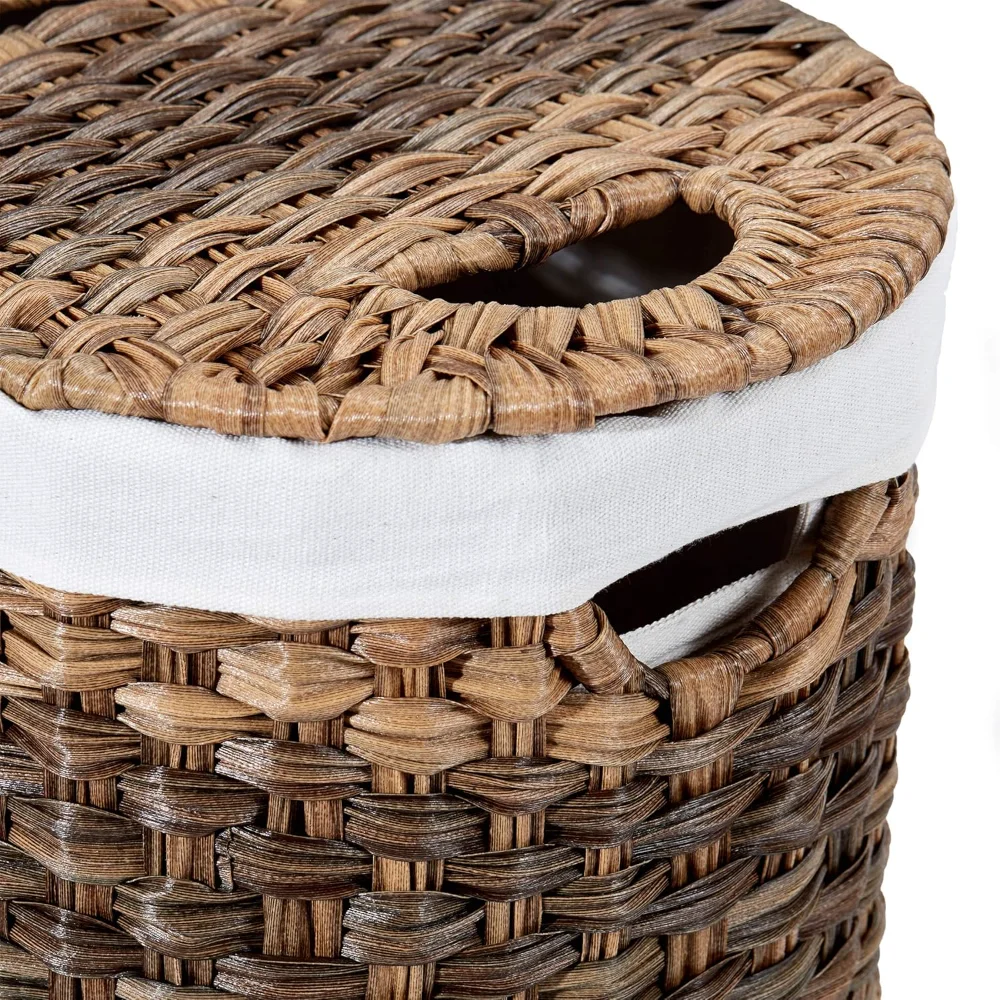
Bamboo’s remarkable sustainability credentials make it a favorite among environmentally conscious consumers. It requires no pesticides to grow, minimal water, and reaches harvest maturity in 3-5 years (compared to decades for most hardwoods). For those interested in minimizing environmental impact, our guide to eco-friendly wicker basket materials provides more detailed information.
Other Natural Fibers: Seagrass, Jute, and Cotton
Beyond the popular options of rattan and bamboo, several other natural materials offer unique benefits for laundry storage:
Seagrass and Water Hyacinth:
– Naturally water-resistant due to their aquatic origins
– Distinctive textural appearance
– Good breathability and strength
– Often more affordable than premium rattan
Jute:
– Extremely durable and strong
– Rustic, earthy aesthetic
– Very affordable compared to other natural options
– Biodegradable and sustainable
Cotton and Canvas:
– Soft-sided flexibility
– Machine-washable convenience
– No risk of snagging delicate fabrics
– Collapsible for easy storage when not in use
– Available in endless colors and patterns
Each material brings unique characteristics to your laundry routine. Our collection of woven laundry baskets showcases the beautiful variety available in natural fiber options, from structured rattan pieces to softer cotton alternatives.
Synthetic Laundry Basket Materials: Practical Solutions for Modern Needs
Synthetic materials offer distinct advantages for laundry baskets, particularly in terms of durability, water resistance, and maintenance. While they may lack the premium aesthetic of natural materials, technological advances have created impressive options that serve specific practical needs.
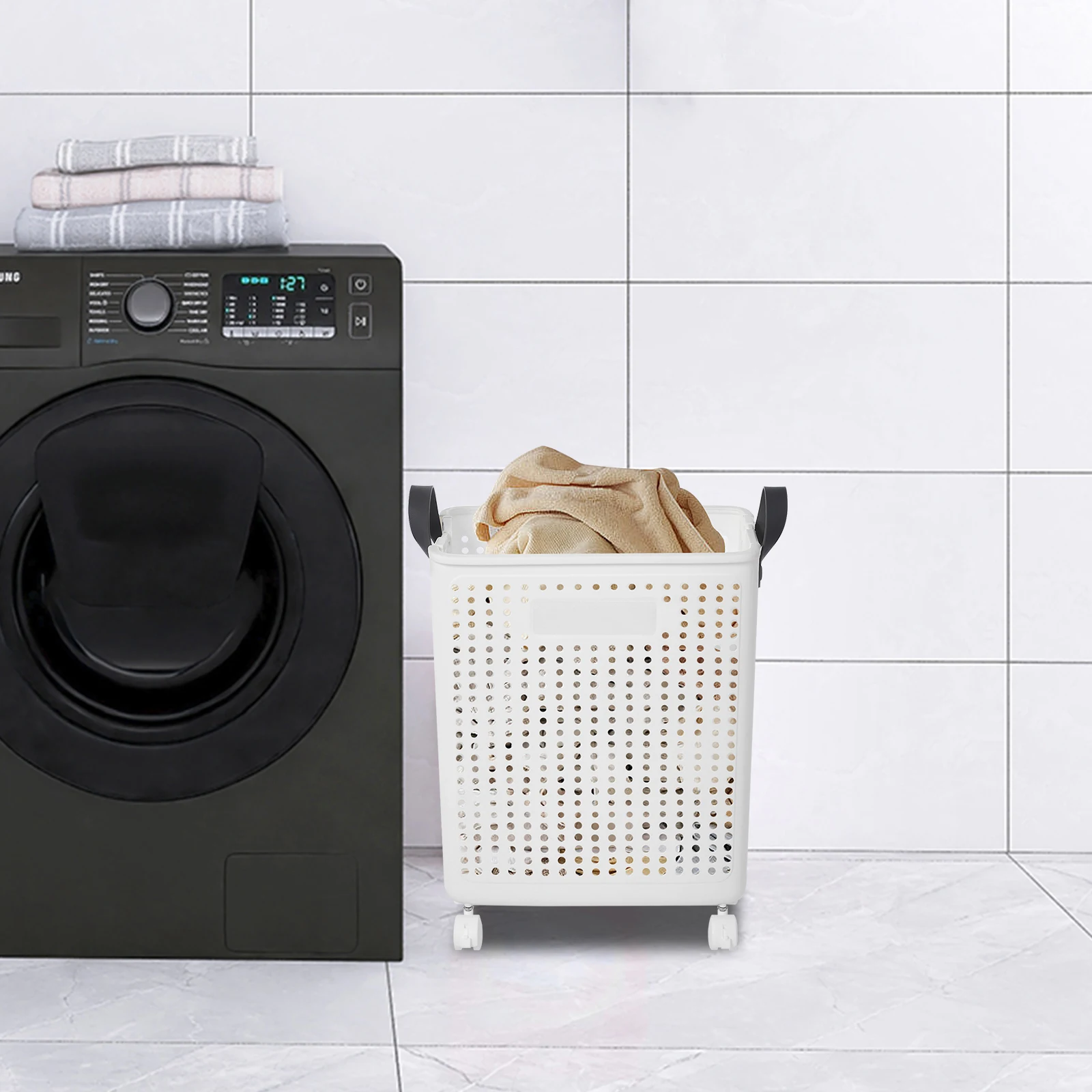
Most synthetic options share several beneficial characteristics:
– High water resistance
– Consistent durability
– Easy cleaning and maintenance
– Lightweight construction
– Lower initial cost
Let’s explore the most common synthetic materials used in modern laundry baskets, with attention to both practical benefits and potential drawbacks. Understanding is synthetic wicker safe for laundry applications helps make informed decisions about these materials.
Plastic Options: Durable and Low-Maintenance
Plastic remains the most common material for laundry baskets, offering practical benefits that make it popular for everyday use.
Types of Plastic Commonly Used:
– Polypropylene (PP): Rigid, durable, and resistant to moisture and chemicals
– Polyethylene (PE): More flexible, good impact resistance
– Recycled Plastic: Environmentally friendlier option using post-consumer waste
Advantages:
– Completely waterproof and easy to clean
– Highly durable with consistent performance
– Available in countless colors and designs
– Ventilated options improve airflow
– Very affordable price point
– Recyclable (though actual recycling rates vary)
Considerations:
– Limited aesthetic appeal compared to natural materials
– Potential for cracking or breaking under heavy loads
– Environmental concerns regarding production and disposal
– May become brittle over time, especially with UV exposure
For those seeking alternatives to plastic options, our wicker laundry baskets collection provides beautiful options that combine functionality with superior aesthetics.
Fabric and Mesh: Lightweight and Portable
Fabric laundry baskets provide unique benefits, particularly for those with space constraints or portability needs.
Common Fabric Types:
– Polyester: Durable and water-resistant
– Oxford Cloth: Thicker and more tear-resistant
– Nylon Mesh: Maximum ventilation and lightweight
Advantages:
– Extremely lightweight even when loaded with laundry
– Many designs fold or collapse for storage
– Often include useful features like carrying handles
– Machine-washable for easy maintenance
– Affordable price point
– Gentle on delicate clothing
Considerations:
– Limited structure; can sag when heavily loaded
– Shorter lifespan than rigid options
– Less visual appeal for visible storage areas
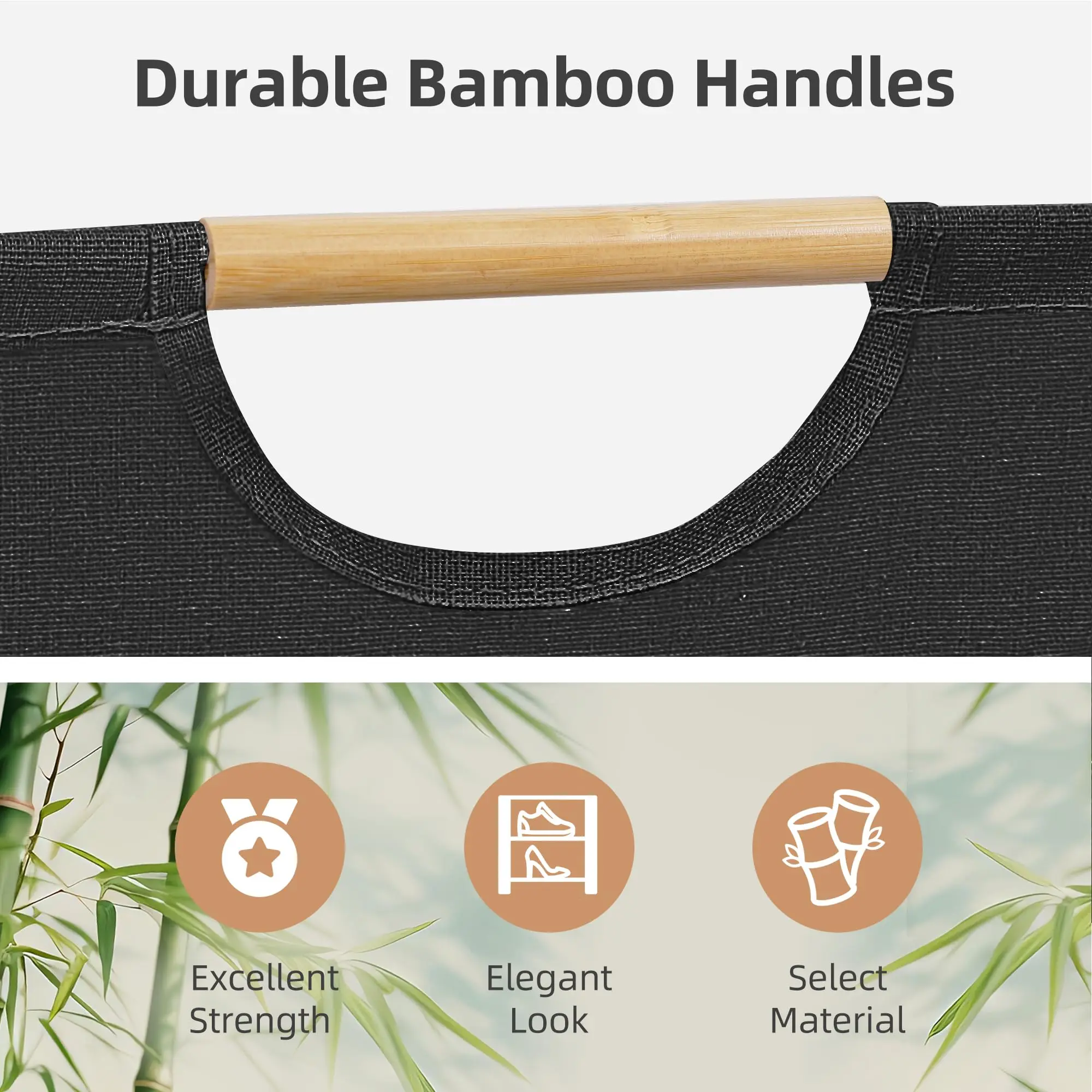
Fabric baskets excel in specific situations like dorm rooms, small apartments, or as secondary laundry baskets for sorting or transporting clothes. Our guide to best collapsible laundry baskets provides more information on space-saving options.
Synthetic Rattan: The Look Without the Maintenance
Synthetic rattan attempts to capture the aesthetic appeal of natural rattan while offering improved durability and weather resistance.
Advantages:
– Resembles natural rattan in appearance
– Complete water resistance
– UV-stable for outdoor use
– No maintenance requirements
– More consistent color and pattern
– Generally less expensive than natural rattan
Considerations:
– Lacks the unique character and texture of natural materials
– Petroleum-based production raises environmental concerns
– Usually not biodegradable
– Can look artificial upon close inspection
Synthetic rattan is manufactured by extruding plastic (usually PVC or polyethylene) through molds to create strands that mimic natural rattan’s appearance. These strands are then woven around frames to create baskets and furniture.
For help deciding between these options, our guide on how to choose between synthetic natural wicker provides detailed comparison points.
Natural vs. Synthetic: A Comprehensive Comparison Matrix
To help you make an informed decision, we’ve created a detailed comparison of the most common laundry basket materials across key performance factors. Each rating is on a 1-5 scale, with 5 being the best performance.
| Material | Durability | Moisture Resistance | Breathability | Ease of Cleaning | Gentleness on Clothes | Weight/Portability | Aesthetic Appeal | Environmental Impact | Price Range |
|---|---|---|---|---|---|---|---|---|---|
| Natural Rattan | 4 | 3 | 5 | 3 | 3 | 3 | 5 | 4 | $$$ |
| Bamboo | 5 | 4 | 4 | 3 | 3 | 3 | 4 | 5 | $$-$$$ |
| Seagrass | 3 | 4 | 4 | 3 | 3 | 3 | 4 | 5 | $$-$$$ |
| Cotton/Canvas | 2 | 2 | 3 | 5 | 5 | 5 | 3 | 4 | $-$$ |
| Plastic | 4 | 5 | 3 | 5 | 3 | 4 | 2 | 1 | $ |
| Fabric (Polyester) | 2 | 3 | 3 | 4 | 5 | 5 | 2 | 2 | $ |
| Synthetic Rattan | 4 | 5 | 3 | 4 | 3 | 3 | 3 | 2 | $$ |
Key Insights from the Comparison:
– Natural materials generally excel in aesthetics, breathability, and environmental impact
– Synthetic materials lead in moisture resistance, ease of cleaning, and initial cost
– The best overall value depends on your specific priorities
Understanding the synthetic vs natural wicker durability differences helps make a more informed long-term investment decision.
Selecting the Right Laundry Basket Material for Your Specific Needs
Finding your perfect laundry basket means matching materials to your specific situation and priorities. Here are recommendations based on common household scenarios:
For Moisture Management and Breathability
If you deal with damp clothes frequently or live in a humid climate, breathability becomes crucial to prevent musty odors and mildew.
Best Materials for Moisture Management:
– Natural rattan and wicker (excellent airflow prevents moisture buildup)
– Ventilated plastic with ample holes
– Bamboo (natural antimicrobial properties)
Worst for Moisture Management:
– Solid plastic without ventilation
– Canvas/fabric that absorbs moisture
In very humid environments, look for baskets with elevated bases to allow airflow from below. Watch for signs like musty odors or visible mold, which indicate insufficient ventilation.
Our wicker laundry baskets with lids provide excellent breathability while offering the option to conceal contents when needed, combining functionality with aesthetics.
For Durability and Heavy Loads
For households with large laundry volumes or those wanting a long-term investment piece, durability becomes the primary consideration.
Best Materials for Durability and Heavy Loads:
– Premium quality natural rattan with reinforced bases and handles
– Heavy-duty polypropylene plastic
– Bamboo (especially with reinforced construction)
Factors That Enhance Durability:
– Reinforced handles and rims
– Double-woven construction techniques
– Sturdy base design
Even durable materials can fail if construction quality is poor. Look for tight, consistent weaving in natural materials and smooth, thick construction in plastics. Our collection of large wicker laundry baskets features reinforced construction specifically designed for heavier loads.
Wicker Laundry Baskets, Woven Laundry Baskets, Woven Storage Baskets
$392.02 Select options This product has multiple variants. The options may be chosen on the product pageLarge Wicker Laundry Baskets, Tall Wicker Baskets, Woven Laundry Hampers, Woven Storage Baskets
$130.54 Select options This product has multiple variants. The options may be chosen on the product pageWoven Laundry Baskets, Woven Laundry Washing Baskets
Price range: $136.76 through $581.37 Select options This product has multiple variants. The options may be chosen on the product pageWicker Hampers with Lids, Wicker Laundry Baskets with Lids, Wicker Laundry Hampers
$127.33 Select options This product has multiple variants. The options may be chosen on the product pageWicker Blanket Baskets, Woven Laundry Baskets
$89.60 Select options This product has multiple variants. The options may be chosen on the product pageLarge Wicker Laundry Baskets, Rattan Laundry Baskets, Woven Laundry Hampers
$162.32 Select options This product has multiple variants. The options may be chosen on the product page
Beyond Material: Additional Features to Consider
While material choice forms the foundation of your laundry basket’s performance, several additional features can enhance functionality regardless of what your basket is made from:
Handles and Grip Options:
– Cutout handles (easy to implement but less comfortable with heavy loads)
– Rope or fabric handles (comfortable grip but may wear over time)
– Reinforced carried handles (ideal for heavier loads)
Lids and Covers:
– Hinged lids for easy access
– Removable covers for versatility
– Ventilated lids that maintain airflow while concealing contents
Additional Practical Features:
– Dividers for pre-sorting laundry
– Removable liners for easy cleaning
– Wheels for improved mobility
– Collapsible designs for storage flexibility
Size and Shape Considerations:
– Rectangular designs maximize space efficiency
– Round or oval shapes may blend better with certain decor styles
– Height impacts visibility of contents and ease of reaching the bottom
The best features depend on your specific needs. A family of four might benefit from dividers to sort laundry, while someone in a small apartment might prioritize a collapsible design that saves space when not in use.
Caring for Your Laundry Basket: Material-Specific Maintenance Tips
Proper care extends the life of your laundry basket, regardless of material. Here are specific maintenance tips for different materials:
Natural Rattan and Wicker:
– Dust regularly with a soft cloth or vacuum with brush attachment
– Clean spills promptly with a damp cloth and dry thoroughly
– Condition occasionally with furniture oil to prevent drying and cracking
– Keep away from direct sunlight and heat sources
– Store in moderate humidity (not too dry or too damp)
Bamboo:
– Wipe with a damp cloth for regular cleaning
– Use mild soap for deeper cleaning, rinse and dry thoroughly
– Apply food-grade mineral oil occasionally to maintain luster
– Avoid prolonged exposure to water
Plastic:
– Clean with soap and water as needed
– Disinfect periodically with diluted bleach solution
– Rinse thoroughly and dry before storing
– Keep away from extreme heat which can cause warping
Fabric and Canvas:
– Machine wash according to tag instructions
– Air dry completely before folding or using
– Check seams periodically for strength
– Avoid overloading which can stretch fabric
Warning signs that your basket needs attention include visible mold, unusual odors, loose weaving, cracking, or broken handles. Addressing these issues promptly can extend your basket’s useful life significantly.
The Tidy Treasure Difference: Why We Choose Premium Natural Materials
At Tidy Treasure, our commitment to quality natural materials reflects our belief that storage solutions should enhance your home, not just serve a function. Our selection process for wicker and rattan pieces involves rigorous quality assessment, focusing on:
- Sustainable sourcing from renewable resources
- Construction quality that ensures longevity
- Consistent, tight weaving patterns that resist stretching
- Reinforced stress points like handles and bases
- Proper finishing to prevent snagging delicate fabrics
We carefully balance beauty with functionality, recognizing that laundry baskets are both utilitarian items and visible elements in your home. Premium natural materials offer several distinct advantages:
- Unique character that enhances home décor
- Superior breathability that prevents odors
- Craftsmanship that ensures longevity
- Sustainable materials that minimize environmental impact
While mass-market options might seem economical initially, premium natural baskets often prove more cost-effective over time, remaining beautiful and functional for many years rather than requiring frequent replacement.
Frequently Asked Questions About Laundry Basket Materials
Is Natural Always Better Than Synthetic for Laundry Baskets?
Not necessarily. The “best” material depends entirely on your specific needs. Natural materials like rattan and bamboo offer superior aesthetics, breathability, and environmental benefits, making them ideal for visible areas and humid environments. Synthetic materials excel in moisture resistance, ease of cleaning, and affordability, making them practical for utility spaces and budget-conscious households. Consider your specific priorities and usage patterns when deciding.
How Can I Tell If a Wicker Basket Is High Quality?
Look for these quality indicators when assessing wicker baskets:
– Even, tight weaving without gaps or inconsistencies
– Smooth finish without rough edges or splinters
– Sturdy construction that doesn’t flex excessively when pressed
– Reinforced handles that are securely attached
– Solid base that sits flat without wobbling
– Natural variations in color (for natural materials)
– Substantial weight relative to size
Poor quality indicators include loose weaving, rough edges, excessive flexibility, and inconsistent patterns.
What’s the Most Eco-Friendly Laundry Basket Material?
Bamboo typically ranks highest for eco-friendliness due to its rapid renewability, minimal growing requirements, and biodegradability. Other natural materials like seagrass, jute, and rattan also score well environmentally. Recycled plastic offers a more eco-friendly synthetic option by diverting waste from landfills. When assessing environmental impact, consider not just the material itself but also production processes, shipping distance, and end-of-life disposal options.
Can Laundry Basket Material Affect My Clothes?
Yes, basket material can definitely impact your clothes. Rough or unfinished natural materials might snag delicate fabrics, while tightly woven materials with smooth finishes are safer. Breathable materials like rattan prevent odors from developing in damp clothes, while non-breathable options may promote mildew that transfers to fabrics. For particularly delicate items like lingerie or cashmere, consider soft-sided fabric baskets or well-finished natural materials with smooth surfaces to prevent damage.



